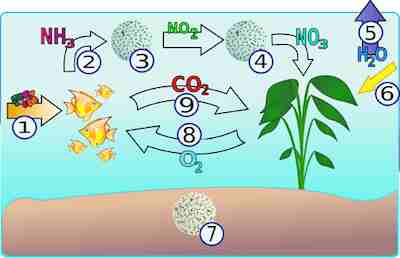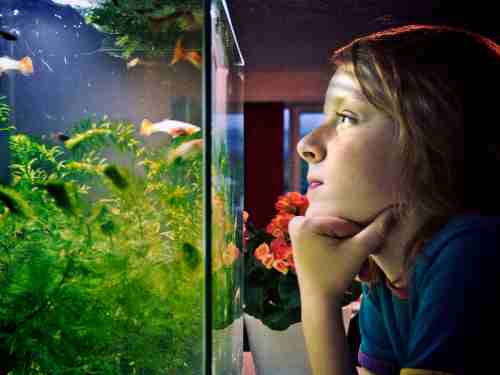Ammonia can be highly harmful to fish, even at less than one part per million, and is an invisibly killer of fish. Fish create ammonia through their gills while breathing; however, they’re not adapted to cope with it because, in nature, it’s diminished by the size of the water bodies they reside in.
In aquaria, we utilize filters, specifically, the beneficial, live bacteria that live within the filters, to naturally reduce ammonia levels. Due to Mother Nature, there are strains of bacteria, known as Nitrifying bacteria, that can convert toxic ammonia to Nitrite, which is harmful, before transforming to less harmful Nitrate.
- Ammonia can be very toxic to fish.
- It is the most frequent cause of death for fish caught in aquariums.
In this post, I will discuss some methods to reduce the amount of ammonia in your aquarium and eventually eliminate it.
Ammonia is a significant issue in the tank that is planted and in regular aquariums too. In reality, it’s highly poisonous to all living creatures in your aquarium.
It is a fast-acting poison that will consume the food chain and ultimately kill all the plant and fish species within your tank. Therefore, we’re here today to assist you in finding a way to lower ammonia levels in your aquarium.
What Causes Ammonia In Fish Tanks?
There is a myriad of reasons that your aquarium may contain high levels of ammonia. If your aquarium is exhibiting high ammonia levels, one of the following causes could be the cause.
Decaying Plants
Plants may also be the reason for the high levels of ammonia in the tank. If your plants aren’t performing well, they could begin to decay or decay in the tank.
If you have plants that are rotting within your aquarium, like the fish that have not been fed, these plants will begin to make and release ammonia to the aquarium. This could increase ammonia levels and.
A simple water change may help to resolve this issue, but eliminating dead plant material is the most effective alternative.
This isn’t a concern if you take care of your plants and keep them in the correct parameters for water and conditions.
Uneaten Fish Food in the Aquarium
One of the most common reasons why the ammonia levels in your aquarium could be excessive is food waste. If uncooked food is left inside the tank for longer than it should, it can begin to decompose and start to rot.

The food that has not been eaten decays and decays; it produces and releases ammonia into the water.
If you are suffering from ammonia issues and your fish is not eating enough, cleaning the tank and changing the water to eliminate food particles could aid.
ways to reduce the amount of ammonia in an aquariums
Partial Water Change
If you find ammonia levels rising in your aquarium, the most efficient and straightforward method to reduce ammonia quickly is to perform one water change.
It is recommended to perform an annual water change of 30 to 50 percent of the aquarium’s water.
Freshly introduced water will be free of ammonia and can help dilute the ammonia present in your aquarium.
How do I do only partial water change?
The first step is that it is recommended to use a fresh bucket that you have not used with soap or chemicals. If you’re not sure, purchase a new bucket and put it set aside for maintenance purposes only for your aquarium. Pour normal drinking water from the tap into your bucket.

Before you introduce tap water to the aquarium, you must remove the chlorine from it. There are two methods to remove chlorine from water. The first method is for you to allow the water to sit for a few hours. If you’re in a situation of emergency, then you must employ a dechlorinating solution that is readily available in the nearest pet shop.
Introduce healthy bacteria into the water.
Colonies of bacilli that typically are found along with the bottom aid in the conversion of ammonia into the relatively harmless nitrogen constituents. 4 If the tank you have is newly constructed or the bacterial population has drastically decreased, it could be that you are suffering from what fish experts refer to as “new tank syndrome.”
A few individuals introduce bacteria by placing one or two fish in the tank so that the waste of the fish can be a source of bacteria. If you choose this method, you can use goldfish for an aquarium with cold water or barbs for warming tanks and damselfish for a saltwater tank.
You can also include healthy bacteria by adding some gravel from an old fish tank into the bottom of your new aquarium.
Improve the water quality and the cleanliness of the water
As you know, ammonia levels will increase because of the organic waste left in the water. Therefore, you must eliminate unnecessary items to achieve a better water quality for the fish you are keeping.
Utilize a fish net to pull all dead plants, extra food and fish waste, everything except living aquarium plants, and fish that aren’t suitable for the fish from the tank.
- Please get rid of each dead fish and ensure that you do make sure they do not affect the other fish.
- Clean the filter to stop it from putting in the waste
- Get rid of the debris that is stuck in the gravel of the tank.
- Aerate and provide water plants for your water.
It is possible to purchase an aeration pump that pushes Ammonia gas dispersion. Ammonia is removed more quickly, which is excellent for the removal of ammonia from the water. Be sure to remove the tank cover for the best results.
Are our aquarium plants helpful in reducing ammonia? The aquatic plants could create an increase in oxygen for the fish and absorb carbonate (CO2) and ammonia created within the tank. This is highly beneficial for the health of the fish and can help lower the NH3 levels naturally.
Reduce the pH in your tank of fish:
If the pH is low (higher than seven on the scale of pH), this can result in more NH3 ammonia, which can be harmful to fish.
It is possible to lower the pH level quickly with the pH solution. It can lower the pH quickly. While lowering the pH will not reduce the amount of ammonia in the tank, it can reduce the chance of getting sick if you don’t alter the water as required.
In addition, do not place in the base of the tank with coral of any kind, as crushed or broken sand as it may result in calcium, which can make the pH go to a high level.
Use neutralizing drops.
One method to temporarily reduce the levels of ammonia in your tank is neutralizing the drops. They are available for purchase these drops at many pet stores or purchase on the internet.
The neutralizing drops don’t take ammonia out of the water. Instead, the bubbles neutralize the harmful effects of ammonia, making ammonia harmless in water.
There’s still a need for biological filtering (from the bacteria) to reduce ammonia into Nitrite and then Nitrate.
symptoms of ammonia in the tank of fish
Lethargy
If you notice that your fish is moving less frequently, this could be why your aquarium is exhibiting high ammonia levels.
But don’t be confused with sleeping fish.
Fish typically sleep on the floor of the aquarium, hovering above the surface of the water.
Fish do not have eyelids which means that their eyes are not closed even when they’re asleep.
Appetite loss
If you find that your fish is eating less than it did previously, it could be a sign of the presence of ammonia in your aquarium.
The surface is flush with gas.
It is common for certain fish to swim onto the surface. However, If you observe that your fish is surfacing regularly to the surface, it could be because your aquarium is exhibiting an elevated ammonia level.
If fish appear to the aquarium’s surface and are gasping for air, it could also indicate insufficient oxygen in the tank.
Inflamed gills
If you notice that the gills are swelling that your fish is, it indicates that your aquarium is awash with ammonia.
Red streaks or inflammation can be seen in the fins.
If you’ve noticed red streaks or a swollen fin on your fish, this could be because your tank is flooded with ammonia.
there are some method to solve problem
Remove Dead Fish
It may be challenging to spot dead fish if you own a large community tank with plenty of hiding spots.
If you are unable to reduce your levels of ammonia, I suggest you look beneath the rocks. You are never sure what you will discover.
Make Sure Your Tank Isn’t Overstocked.
Some beginners have too many fish too quickly.
If you’ve got excessive fish, the bacterial load that is accumulating in your tank hasn’t yet established itself and can’t meet the volume of waste created by fish.
Conclusion
Apart from using chemicals, all of the above solutions are the most effective solution for “How do I get rid of ammonia in my fish tank naturally.” The most crucial thing for the natural prevention of ammonia poisoning is feeding the fish well, choosing the appropriate amount, and building a biological filter.
Ammonia levels that are high in the tank of your fish are hazardous. The best way to lower the amount of ammonia in a tank of fish is only five steps that are easy to accomplish, so you can follow these steps regularly to keep the fish in a healthy environment. It will also reduce any risks that could affect your fish. Don’t wait until your fish has died before you can fix the issue since your fish deserves better.
Please share and comment on this blog if you like the information. If you think you’ve got an alternative solution or require assistance, don’t feel afraid to contact us, and we’ll get back to you as soon as we can.